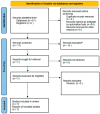Asymmetric Dimethylarginine as a Potential Mediator in the Association between Periodontitis and Cardiovascular Disease: A Systematic Review of Current Evidence
- PMID: 39329863
- PMCID: PMC11431043
- DOI: 10.3390/dj12090297
Asymmetric Dimethylarginine as a Potential Mediator in the Association between Periodontitis and Cardiovascular Disease: A Systematic Review of Current Evidence
Abstract
Background: Periodontitis, a chronic inflammatory disease, has been associated with an elevated risk of cardiovascular disease (CVD). Asymmetric dimethylarginine (ADMA), an endogenous inhibitor of nitric oxide synthase, has emerged as a potential biomarker linking periodontitis, endothelial dysfunction, and CVD. This systematic review aimed to synthesize the existing evidence on the relationship between ADMA, periodontitis, and CVD, and to evaluate ADMA's potential as a biomarker for periodontal disease progression and its correlation with endothelial dysfunction. Methods: A comprehensive literature search was conducted in PubMed, Scopus, and Web of Science databases from their inception to March 2023. Observational and interventional studies assessing ADMA levels in patients with periodontitis and/or CVD were included. The methodological quality of the included studies was evaluated using the NIH Quality Assessment Tools. Due to the heterogeneity of the included studies, a qualitative synthesis was performed. Results: Cross-sectional studies consistently demonstrated significantly elevated ADMA levels in patients with periodontitis and CVD compared to healthy controls. The prospective cohort study indicated that successful periodontal treatment was associated with a significant reduction in ADMA levels and concomitant improvement in endothelial function. The pilot cohort study reported a significant decrease in ADMA levels following periodontal therapy in patients with chronic kidney disease. However, the randomized controlled trials did not demonstrate significant alterations in ADMA levels or endothelial function subsequent to periodontal treatment in patients with periodontitis alone. Conclusions: Periodontal treatment may effectively reduce ADMA levels and improve endothelial function, particularly in patients with comorbidities. These findings suggest that ADMA is a promising biomarker linking periodontitis, endothelial dysfunction, and CVD. However, the limitations of this study include the small number of studies, heterogeneity in the study designs, and a lack of long-term follow-up data. Further high-quality, longitudinal studies are required to confirm its clinical utility and elucidate the underlying mechanisms of these relationships. The integration of periodontal care into CVD prevention and management strategies warrants consideration, as it may contribute to mitigating the cardiovascular risk associated with periodontitis.
Keywords: asymmetric dimethylarginine (ADMA); cardiovascular disease; endothelial dysfunction; inflammation; nitric oxide synthase; oxidative stress; periodontitis.
Conflict of interest statement
The authors declare no conflicts of interest.
Figures
Similar articles
-
The Impact of Periodontal Inflammation on Endothelial Function Assessed by Circulating Levels of Asymmetric Dimethylarginine: A Single-Blinded Randomized Clinical Trial.J Clin Med. 2022 Jul 18;11(14):4173. doi: 10.3390/jcm11144173. J Clin Med. 2022. PMID: 35887937 Free PMC article.
-
Evaluation of salivary and serum methylated arginine metabolites and nitric oxide synthase in advanced periodontitis patients.Clin Oral Investig. 2022 Jul;26(7):5061-5070. doi: 10.1007/s00784-022-04479-w. Epub 2022 Apr 14. Clin Oral Investig. 2022. PMID: 35426000
-
Asymmetric and symmetric dimethylarginine concentration as an indicator of cardiovascular diseases in rheumatoid arthritis patients: a systematic review and meta-analysis of case-control studies.Clin Rheumatol. 2020 Jan;39(1):127-134. doi: 10.1007/s10067-019-04713-z. Epub 2019 Aug 3. Clin Rheumatol. 2020. PMID: 31376089
-
Asymmetric Dimethylarginine (ADMA): a promising biomarker for cardiovascular disease?Curr Top Med Chem. 2013;13(2):180-200. doi: 10.2174/1568026611313020007. Curr Top Med Chem. 2013. PMID: 23470077 Review.
-
Asymmetric dimethylarginine, endothelial dysfunction and renal disease.Int J Mol Sci. 2012;13(9):11288-11311. doi: 10.3390/ijms130911288. Epub 2012 Sep 10. Int J Mol Sci. 2012. PMID: 23109853 Free PMC article. Review.
Cited by
-
Exploring the outcomes of non-surgical periodontal therapy in modulating periodontal parameters, renal function, and inflammatory biomarkers in chronic kidney disease patients with periodontitis.PeerJ. 2025 May 29;13:e19492. doi: 10.7717/peerj.19492. eCollection 2025. PeerJ. 2025. PMID: 40452929 Free PMC article.
References
-
- Tsioufis C., Thomopoulos C., Soldatos N., Syrseloudis D., Kasiakogias A., Silvestros S., Stefanadi E., Mostratou E., Stefanadis C. The conjoint detrimental effect of chronic periodontal disease and systemic inflammation on asymmetric dimethyl-arginine in untreated hypertensive subjects. Atherosclerosis. 2010;208:258–263. doi: 10.1016/j.atherosclerosis.2009.07.017. - DOI - PubMed
Publication types
LinkOut - more resources
Full Text Sources


